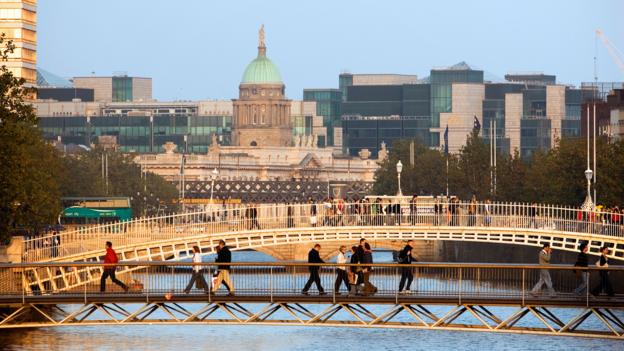
Growing a reputation as Europe’s “Silicon Valley”, Dublin is attracting new businesses from around the world – and they’re bringing a host of expats to Ireland with them.
More than 600 American companies alone – including Facebook and Pfizer – have moved part of their business to the Emerald Isle in the last few years, employing more than 100,000 workers and taking advantage of the appealing 12.5% corporate tax rate.
Despite the recent growth, however, the city is a still a place where tradition thrives. “Most people like to get together after work or during the weekend for a pint,” said Julie Eboutou, who works for expat organisation InterNations and is originally from Yaoundé, Cameroon. “Drinking beer can be considered as a ‘tradition’ in Ireland, and especially in Dublin!”
In fact, that’s one way you can usually tell the difference between an expat and a native. “Irish locals are pretty much always up for a chat or a pint!” said John Brett, a software developer from County Laois, 95km southwest of Dublin.
In the small, but busy city, “it’s easy to find concerts, clubs and festivals if you’re a party-goer,” said Kevin Bosc, who also works for InterNations and is originally from Valence, France. He added, though, that Dublin is definitely more laidback and slow-paced than other European capitals such as Paris or London.
Where do you want to live?
“Single expats would do well to live in [the city centre], in order to meet new people and make friends,” Eboutou said. “And for expats whose first language is not English, this will speed up their language skills.”
Just 2km to the southeast, the Grand Canal dock area is a good alternative to the often busy and touristy centre. “I love this area as it is modern, peaceful and near all the big tech companies such as Facebook and Google,” Bosc said. Popular with expats in their 20s and 30s, the canal neighbourhood has lots of restaurants and bars. “This area is definitely lively, especially during the weekend when people go out for brunch or relax around the canal,” he added.
Further afield, suburban areas like Ranelagh and Rathmines offer alternatives for families, with bigger living spaces and more of a countryside feel.
What do you want to live in?
The closer to the city centre, the more likely it is for people to live in apartments, although shared houses are popular in the surrounding neighbourhoods.
“I live in a house, sharing with friends. Most people would live like this, or in an apartment closer to the city centre, but nearly always sharing,” Brett said. A severe housing shortage has driven rents to record highs, up 9% in 2015 from the previous year, with the average rent for a house hovering around 1,400 euros, and 1,265 euros for an apartment. Still, housing costs about 45% less than similar accommodation in London, according to pricing site Expatistan.com.
While much of Dublin’s older architecture was demolished during the city’s rapid 20th-century growth, historic Georgian buildings – marked by a symmetrical design that’s influenced by classic Greek and Roman architecture – can still be found in parts of the city, particularly in Fitzwilliam Square, 2km south of central Dublin.
Where can you travel?
Day trips are an ever-popular option among residents since the entire island can be traversed in a two-to-four-hour drive. The small country enables easy trips to nearby cities, like the seaside-resort town of Bray, 21km south of Dublin, or Kilkenny, known for being a cultural hub of galleries, museums and festivals, 130km southwest of the capital. County Clare, 250km west of Dublin, is where expats go to immerse themselves in the heart of Irish music, especially in July when the famous Willie Clancy Summer School – centred around Irish music and dance and the associated oral tradition – commences, and organised recitals and impromptu concerts take over the town for the week.
Dublin’s airport also has fast and frequent service to the rest of Europe. London is just an hour, Paris is two hours and Rome three hours away. The prevalence of budget airlines can makes the round-trip as affordable as 40 euros.
How much does it cost?
Costs are quickly rising in Dublin, especially with the growth in international business operations. According to the Economist’s 2015 Cost of Living Index, Dublin is the 24th most expensive city in the world, well behind London and Paris, but more expensive than Rome or Madrid.
Finding affordable housing is a particular challenge. “It’s becoming more and more difficult to find a good place to live for a reasonable price,” Bosc said. “Other than rent, I’d say Dublin is affordable. But it definitely looks like it’s going to change and get more expensive.”










